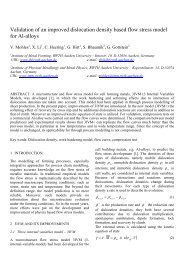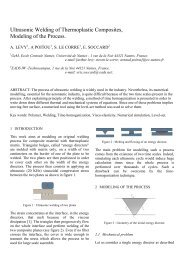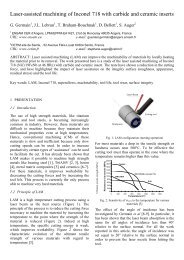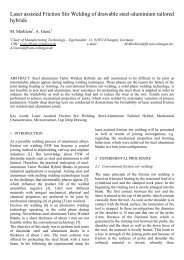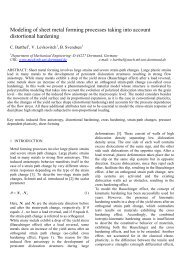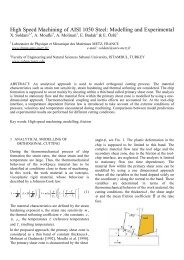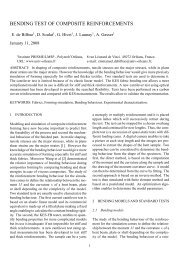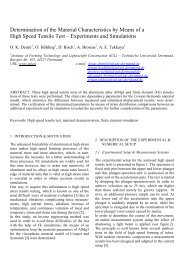Here - the ESAFORM 2008 Conference - INSA de Lyon
Here - the ESAFORM 2008 Conference - INSA de Lyon
Here - the ESAFORM 2008 Conference - INSA de Lyon
Create successful ePaper yourself
Turn your PDF publications into a flip-book with our unique Google optimized e-Paper software.
occurring at tool-chip-workpiece interfaces during<strong>the</strong> high speed dry cutting of a AISI 316L stainlesssteel with TiN coated carbi<strong>de</strong> tools.(a)Fig. 2. Various technologies of tribometer (a) Olsson’stribometer [5], (b) Zemzemi’s tribometer [5], (c) He<strong>de</strong>nqvist’stribometer [6].(c)2 EXPERIMENTAL SET-UP2.1 Material <strong>de</strong>scriptionA cylindrical bar, ma<strong>de</strong> of AISI 316L, is fixed ontoa la<strong>the</strong> chuck, as illustrated in Figure 3.4-Pneumatic jack6-DynamometerForcesmeas.FtFn2-Cutting toolrefreshing<strong>the</strong> surface5-Pin hol<strong>de</strong>r(b)3- Pin :Carbi<strong>de</strong> +TiN coating7-Thermistor1-Workpiece :316LHeat Fluxmeas.Fig. 3. Tribometer <strong>de</strong>signed for cutting applications.A pin ma<strong>de</strong> of cemented carbi<strong>de</strong> with a TiN coatingand having a spherical geometry Ø 9 mm is pressedonto <strong>the</strong> cylindrical surface by means of a jack.Thanks to <strong>the</strong> helical trajectory of pin, <strong>the</strong> surfacecontact is continuously regenerated. The pin ismaintained by an instrumented pin-hol<strong>de</strong>r able toprovi<strong>de</strong> data about <strong>the</strong> instantaneous heat fluxentering into <strong>the</strong> pin [7]. It is fixed onto adynamometer, in or<strong>de</strong>r to provi<strong>de</strong> <strong>the</strong> apparentnormal and tangential force (macroscopic forces).After each friction test, a cutting tool refreshes <strong>the</strong>surface and a belt finishing operation is performed inor<strong>de</strong>r to obtain a very low initial surface roughness.2.2 Testing conditionsTesting conditions have to be chosen in accordancewith <strong>the</strong> frictional conditions estimated along <strong>the</strong>tool/chip/workpiece interfaces. For instance, <strong>the</strong>machining of a AISI 316L with a TiN coated carbi<strong>de</strong>tool in dry cutting conditions is around Vc~120m.min -1 . Based on Figure 1, it is of evi<strong>de</strong>nce that <strong>the</strong>macroscopic sliding speed at <strong>the</strong> tool-workpieceinterface is almost equal to <strong>the</strong> cutting speed ~ 120m.min -1 . On <strong>the</strong> chip-tool interface, <strong>the</strong> averagesliding velocity <strong>de</strong>pends on <strong>the</strong> compression ratio β,which is around 2. So at this interface, <strong>the</strong>macroscopic velocity is 2 times lower than <strong>the</strong>cutting speed 60 m.min -1 . As a consequence, <strong>the</strong>characterization of <strong>the</strong> frictional properties at <strong>the</strong>tool/chip/workpiece interface needs performingfriction tests in <strong>the</strong> following conditions: slidingvelocity: 60-120 m.min -1 , pressure: 1-2 GPa [2].2.3 Experimental resultsThe sliding velocity was <strong>the</strong> single modifiedparameter in this work. A normal force equal toabout 1000 N has been applied onto pins, which leadto an average pressure of 1.8 GPa.The first output data provi<strong>de</strong>d by this set-up is <strong>the</strong>ratio between <strong>the</strong> tangential and <strong>the</strong> normal force.This coefficient can be <strong>de</strong>fined as an apparentfriction coefficient Ftµapp= . (1)FThe evolution of µ app versus sliding velocity isplotted in Figure 4. This confirms that it is notrelevant to consi<strong>de</strong>r <strong>the</strong> friction coefficient asin<strong>de</strong>pen<strong>de</strong>nt from sliding speed. Over 120 m.min -1 , amodification of <strong>the</strong> frictional behavior is observed.nWorkmaterial : AISI 316 L steelPin : Carbi<strong>de</strong> + TiN coatingSphere diameter : 9 mmFig. 4. Apparent friction coefficient.



